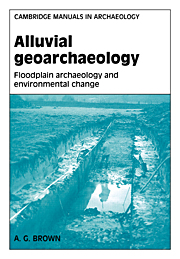Book contents
- Frontmatter
- Contents
- List of illustrations
- List of tables
- Preface
- Acknowledgements
- Introduction and the example of the Nile
- PART I PRINCIPLES
- 1 Floodplain evolution
- 2 Alluvial environments over time
- 3 Interpreting floodplain sediments and soils
- 4 Floodplain ecology, archaeobotany and archaeozoology
- PART II APPLICATION
- APPENDICES
- References
- Subject Index
- Index of rivers and sites
2 - Alluvial environments over time
Published online by Cambridge University Press: 03 December 2009
- Frontmatter
- Contents
- List of illustrations
- List of tables
- Preface
- Acknowledgements
- Introduction and the example of the Nile
- PART I PRINCIPLES
- 1 Floodplain evolution
- 2 Alluvial environments over time
- 3 Interpreting floodplain sediments and soils
- 4 Floodplain ecology, archaeobotany and archaeozoology
- PART II APPLICATION
- APPENDICES
- References
- Subject Index
- Index of rivers and sites
Summary
As the last chapter illustrated, floodplains have a history – they evolve over time. In order to be able to unravel this history and relate it to other events, be they climatic or cultural, sediments have to be sequenced and dated. Advances in dating have revolutionised not only archaeology (Renfrew and Bahn, 1991) but also recent geology (Vita-Finzi, 1973), and the development of sediment-based techniques will undoubtedly have a major impact on studies of the environmental archaeology of past societies, particularly in alluvial environments.
Dating and alluvial chronologies
The stratigraphy of a floodplain represents a time-sequence, so the development of the floodplain over time can be investigated if the stratigraphy can be dated. The dated alluvial stratigraphy or alluvial chronology can then be correlated with, or even used to date, human activity on the floodplain or in the river catchment. As with other Quaternary sediments, there are two, fundamentally different, groups of dating methods that are commonly used to date alluvial sequences. These are the chronometric methods that provide independent age estimates, either numerical or calibrated, but based upon some kind of physical, chemical or biological clock. Other methods are relative, in the sense that they operate both through stratigraphic order and through matching stratigraphic sequences to a similar sequence elsewhere which may be chronometrically dated. Some relative methods can be so well correlated to chronometrically dated or historical sequences that they can be regarded as a third category: calibrated relative methods.
- Type
- Chapter
- Information
- Alluvial GeoarchaeologyFloodplain Archaeology and Environmental Change, pp. 45 - 62Publisher: Cambridge University PressPrint publication year: 1997



